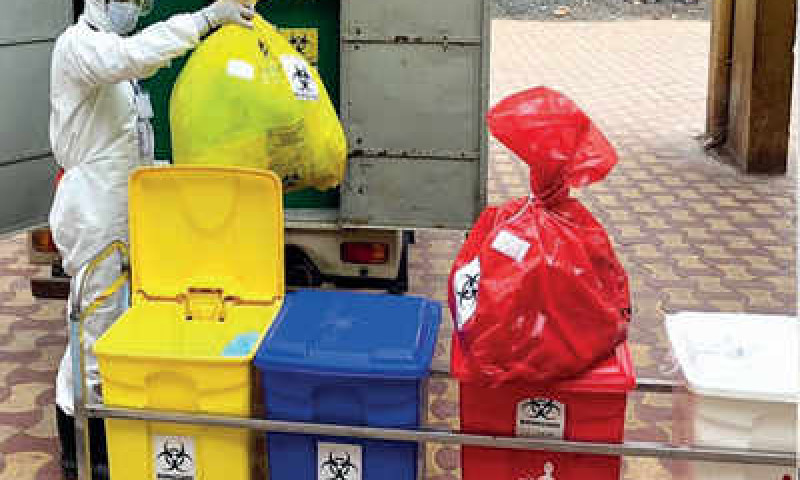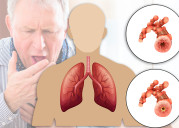Waste management during Covid-19

The first case of COVID-19 was reported from Hubei Province of China on 31 December 2019. Public Health Emergency of International Concern (PHEIC) has been declared on 30 January 2020 and Pandemic on 11 March 2020. Illness caused by coronavirus was termed as COVID-19 by the WHO, which is derived from "coronavirus disease 2019". The name was selected to avoid stigmatizing the virus's origins in terms of populations, geography or animal associations.
Sukraraj Infectious and Tropical Disease Hospital (STIDH) in Teku, Kathmandu has been designated by the Government of Nepal (GoN) as the primary hospital along with Patan Hospital and the Armed Police Forces Hospital in the Kathmandu Valley.
Recently, all the central hospitals, provincial hospitals, medical colleges, academic institutions and hub-hospitals have been designated to provide treatment care for COVID-19 cases. So far, more than 2000 hospital beds across the country are allocated for isolation of suspected and confirmed cases.
At this stage of operation, the major challenge has been managing quarantine, human resources, limited laboratories for testing and limited stock of medical supplies for the response which includes personal protective equipment and other supplies. But no one is thinking about waste management which can be one of factor for community transfer of covid-19 during this pandemic.
According to the Medical Waste (Management and Processing) Rules 2008, "medical wastes could not be mixed with other wastes at any stage while producing inside hospitals, while collecting from hospitals, while transporting, and would be processed separately based on classification".
The ongoing COVID-19 pandemic has already turned healthy places around the world into a living hell with massive death tolls because of its fastest spreading nature, and continuously leading to lockdowns in almost every part of the world. Amid all the problems so far it created, one significant problem that can create major destruction in this already devastating and contagious atmosphere in a densely populated city is not handling medical waste properly.
China’s Wuhan, the first of the cities that got viciously brutalized by the pandemic, is home to 11 million people. Its hospitals produced more than 240 tones of medical waste daily during the peak of the outbreak compared with 40 tones before the epidemic occurred, according to China’s Ministry of Ecology and Environment’s emergency office.
To fight this enormous amount of medical wastages, the central government deployed 46 mobile medical waste treatments facilitates to the city of Wuhan and built a new plant with a capacity of 30 tonnes within 15 days in March. Biomedical wastes are hazardous because they host potential virus particles that can be hidden beneath human tissues, items contaminated with blood bags, needles, syringes or any other sharp object, body fluids-remaining like dressings, plaster casts, cotton swabs, beddings contaminated with blood or body fluid etc.
Experts say medical wastages are not like other wastes such as the household or industrial wastages. It can infect one directly through the skin or by ingestion and inhalation with objects like inhalers or ventilating pipes.
Many contagious viruses including HIV and Hepatitis (B and C) can easily be generated from such wastes and can harm the ones who do not have the diseases. Germs and viruses, which are antibiotic-resistant (such as the COVID-19 at this point) can easily spread from medical waste. Biomedical wastes are hazardous because they host potential virus particles that can be hidden beneath human tissues, items contaminated with blood bags, needles, syringes or any other sharp object, body fluids-remaining like dressings, plaster casts, and cotton swabs, beddings contaminated with blood or body fluid etc Healthcare facilities should continue to handle infectious waste following medical waste management procedures.
At this time, there are no indications that the presence of the Corona virus at a healthcare facility will create new infectious waste streams requiring special handling. For instance, hospital waste such as disinfecting wipes, personal protective equipment, or disposable food ware may be disposed of as solid waste in the trash. Per usual guidance, all non-recyclable wastes from households and hospitals should be bagged and tied before placed in a trash receptacle. All of these wastes should be disposed of in a solid waste landfill permitted to accept municipal solid waste.
Safe management of health care waste during COVID-19
Best practices for safely managing health-care waste should be followed, including assigning responsibility and sufficient human and material resources to segregate and dispose of waste safely. There is no evidence that direct, unprotected human contact during the handling of health-care waste has resulted in the transmission of the COVID-19 virus.
All health-care waste produced during patient care, including those with confirmed COVID-19 infection, is considered to be infectious (infectious, sharps and pathological waste) and should be collected safely in clearly marked lined containers and sharp safe boxes. This waste should be treated, preferably on-site, and then safely disposed. If waste is moved off-site, it is critical to understand where and how it will be treated and disposed. Waste generated in waiting areas of health-care facilities can be classified as non-hazardous and should be disposed in strong black bags and closed completely before collection and disposal by municipal waste services.
All those who handle health-care waste should wear appropriate PPE (boots, long-sleeved gown, heavy-duty gloves, mask, and goggles or a face shield) and perform hand hygiene after removing it. The volume of infectious waste during the COVID 19 outbreak is expected to increase, especially through the use of PPE. Therefore, it is important to increase capacity to handle and treat this health-care waste. Additional waste treatment capacity, preferably through alternative treatment technologies, such as autoclaving or high temperature burn incinerators, may need to be procured and systems may need to be put in place to ensure their sustained operation.
PPE (long-sleeved gown, gloves, boots, masks, and goggles or a face shield) should be worn at all times when handling or transporting excreta offsite, and great care should be taken to avoid splashing. For crews, this includes pumping out tanks or unloading pumper trucks. After handling the waste and once there is no risk of further exposure, individuals should safely remove their PPE and perform hand hygiene before entering the transport vehicle.
Soiled PPE should be put in a sealed bag for later safe laundering. Where there is no off-site treatment, inside treatment can be done using sodium hypochoride(0.5-1%).
Impacts of Corona Virus on Solid Waste Management
Regulated medical waste will be produced from the COVID-19 outbreak, which may include needles, sharps, material contaminated with bodily fluids (like gauze, gloves or gowns) and pathological wastes. These wastes are regulated federally by the Occupational Safety and Health Administration (OSHA) for safe handling and the Department of Transportation for transportation as well as at the state level for the management and treatment of these materials before disposal.
According to the U.S. Centers for Disease Control and Prevention (CDC), risk of catching COVID-19 is higher for people who are in close contact with someone who already has the disease. The virus is thought to spread mainly through respiratory droplets (not truly airborne) produced when an infected person coughs or sneezes. It also may be possible that a person can get COVID-19 by touching a surface or object that has the virus on it and then touching their own mouth, nose or possibly their eyes, but this is not thought to be the main way the virus spreads.
However, OSHA states that without sustained human-to-human transmission, most American workers are not at significant risk of infection. Exposure risk may be elevated for some workers, including those involved in solid waste and wastewater management.
The CDC has determined that medical waste generated in the treatment of COVID-19 patients and patients under investigation (PUIs) be managed in accordance with routine procedures.
According to CDC, waste generated in the care of PUIs or patients with confirmed COVID-19 does not present additional considerations for wastewater disinfection in the U.S. Coronaviruses are susceptible to the same disinfection conditions in community and healthcare settings as other viruses, so current disinfection conditions in waste water treatment facilities are expected to be sufficient.
According to the guidelines, healthcare facilities having isolation wards for COVID-19
patients need to keep separate color coded bins/ bags/containers in wards and maintain proper segregation of waste.
As precaution double layered bags (using 2 bags) should be used for collection of waste from COVID-19 isolation wards so as to ensure adequate strength and no-leaks. Collect and store biomedical waste separately prior to handing over the same to Common Bio-medical Waste Treatment and Disposal Facility (CBWTF). Use a dedicated collection bin labelled as 'COVID-19' to store COVID-19 waste and keep separately in temporary storage room prior to handing over to authorize staff of CBWTF. Biomedical waste collected in such isolation wards can also be lifted directly from ward into CBWTF collection van.
In addition to mandatory labelling, bags/containers used for collecting biomedical waste from COVID-19 wards, should be labelled as 'COVID-19 Waste, it said adding that general waste not having contamination should be disposed as solid waste as per Solid Waste Management Rules, 2016.
Maintain separate record of waste generated from COVID-19 isolation wards. Use dedicated trolleys and collection bins in COVID-19 isolation wards. A label 'COVID-19 Waste' to be pasted on these items also. The (inner and outer) surface of containers/bins/trolleys used for storage of COVID-19 waste should be disinfected with 1 percentsodium hypochlorite solution daily.
Conclusion
If the massive amount of medical wastages cannot be managed through maintaining proper and adequate guidelines, chances of community-based spreading of COVID-19 can exceed the limit and take more lives in the upcoming days.
(Dr.Sharma is a Sr.Microbiologits & Infecsious diseases Expert in National Publichealth Lab)














